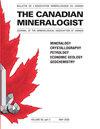Complex Weblike Hydrogen Bonding in Large “Drain Pipe” Channels of Wightmanite Revealed by New X-Ray and Spectroscopic Measurements
IF 1.5
4区 地球科学
Q3 MINERALOGY
引用次数: 1
Abstract
The wallpaper-type crystal structure of wightmanite, Mg5(BO3)O(OH)5·1–2H2O, has been reanalyzed in order to better understand the position and bonding of hydrogen atoms. Single-crystal structure refinement yielded the monoclinic I2/m unit cell a = 13.5165(18), b = 3.0981(3), c = 18.170(3)Å, ß = 91.441(6)°, and V = 760.65(17)Å3, Z = 4. Hydrogen atoms of OH groups pointing to the inside of the elliptical channels oriented parallel to [010] are arranged in the form of two overlying, a–c parallel planar pentagons. The two pentagons point in opposite directions. Hydrogen-bond analysis shows that the hydroxyl groups are linked by complex polyfurcated, intra-molecular hydrogen bonds forming a web-like network coating the walls of the channels. The longest distance between hydrogens (7.226 Å) is observed in the pentagonal planes of the channel. The anisotropically refined oxygen atoms of the zeolitic water show their strongest vibration parallel to the b axis and in the direction of the largest diameter of the elliptical channel and similarly form a complex inter-molecular hydrogen-bond system to the hydroxyl groups coating the channel walls. This complex bonding is expressed in the Raman spectrum by a broad band between 3100 and 3300 cm–1 that is assigned to the OH / H2O stretching mode and one strong band at 3661 cm–1 attributable to an OH-stretching mode. Infrared spectra also show a pronounced broad band between 3200 and 3700 cm–1 attributed to H2O and OH-stretching modes. The weak bands around 1600 cm–1 observed in the Raman and IR spectra are probably due to relatively weakly bound water in the channels.新的X射线和光谱测量揭示了Wightmanite大型“排水管”通道中复杂的网状氢键
为了更好地了解氢原子的位置和键合,重新分析了镁镁石的壁纸型晶体结构Mg5(BO3)O(OH)5·1–2H2O。单晶结构细化产生单斜I2/m晶胞a=13.5165(18),b=3.0981(3),c=18.170(3)Å,ß=91.441(6)°,V=760.65(17)Å3,Z=4。指向平行于[010]取向的椭圆通道内部的OH基团的氢原子以两个重叠的a–c平行平面五边形的形式排列。两个五边形指向相反的方向。氢键分析表明,羟基通过复杂的多分叉分子内氢键连接,形成覆盖通道壁的网状网络。氢之间最长的距离(7.226Å)是在通道的五角平面中观察到的。沸石水的各向异性精制氧原子在平行于b轴和椭圆通道的最大直径方向上表现出最强的振动,并且类似地与覆盖通道壁的羟基形成复杂的分子间氢键系统。这种复合键在拉曼光谱中由3100和3300 cm–1之间的宽带表示,该宽带属于OH/H2O拉伸模式,3661 cm–1处的一个强带属于OH拉伸模式。红外光谱还显示,由于H2O和OH拉伸模式,在3200和3700 cm–1之间有一个明显的宽带。在拉曼光谱和红外光谱中观察到的1600 cm–1左右的弱带可能是由于通道中相对较弱的结合水。
本文章由计算机程序翻译,如有差异,请以英文原文为准。
求助全文
约1分钟内获得全文
求助全文
来源期刊

Canadian Mineralogist
地学-矿物学
CiteScore
2.20
自引率
22.20%
发文量
45
审稿时长
4-8 weeks
期刊介绍:
Since 1962, The Canadian Mineralogist has published papers dealing with all aspects of mineralogy, crystallography, petrology, economic geology, geochemistry, and applied mineralogy.
 求助内容:
求助内容: 应助结果提醒方式:
应助结果提醒方式:


